-
October 11, 2017 by Total Fire and Safety

On Thursday, June 29, 2017, the Total Fire & Safety family said goodbye to a much-loved matriarch, Mary Ann Schultz. She was the wife of Total Fire & Safety’s founder, Glenn Schultz, and was always a great supporter of the family business. She was the loving mother of four children and eleven grandchildren. She lived in the Chicago suburbs for much of her adult life, and was involved in the community, through church and the family business.
Mary Ann’s family (her husband Glenn and children Kerry, Bryan, Michelle and Brad) have started a fundraiser in Mary Ann’s name. They are fundraising for the Leukemia and Lymphoma Society, through the Light the Night Walk which will take place October 21, 2017 in the Oak Brook Park District. Those who wish to remember Mary Ann by supporting this cause can donate, or register to walk on the Schultz’s team, “Strong Like You.”
We here at Total Fire & Safety offer our greatest condolences to the Schultz family, and support them in their efforts to fund research for a future without blood cancers. They are well on their way to making their goal of $5,000 in donations. Those who wish to donate or register for the Light the Night Walk can do so at: http://pages.lightthenight.org/il/wsuburban17/StrongLikeYou
Update as of October 22, 2017: The walk raised $7,600 in Mary Ann’s name. Thank you all for participating!
Category: Total Fire and Safety, Uncategorized Tags: Mary Ann, Mary Ann Schultz, Mary Ann Shultz Obituary, Mary Schultz | Comments Off on Total Fire & Safety Remembers Mary Ann Schultz
-
September 4, 2017 by Total Fire and Safety
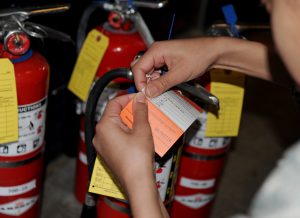 Walk into any building and you’re sure to see a fire extinguisher hanging somewhere on a wall, and although it doesn’t look it, that extinguisher requires maintenance. It does more than just sit idly until a dire situation calls for its immediate use. Most people overlook these crucial pieces of safety equipment—often to the point of not even knowing anything about it. Think about the fire extinguisher in your home or office—do you know if it is fully charged? Do you know if you will be able to depend on it to successfully extinguish a flame if the need arises? Walk into any building and you’re sure to see a fire extinguisher hanging somewhere on a wall, and although it doesn’t look it, that extinguisher requires maintenance. It does more than just sit idly until a dire situation calls for its immediate use. Most people overlook these crucial pieces of safety equipment—often to the point of not even knowing anything about it. Think about the fire extinguisher in your home or office—do you know if it is fully charged? Do you know if you will be able to depend on it to successfully extinguish a flame if the need arises?
This is why the National Fire Protection Association (NFPA) requires that that all portable fire extinguishers be inspected on a monthly basis (NFPA 10, Section 6.2.1) and maintained by a licensed fire protection company on an annual basis. (NFPA 10, Section 6.3.1)
We take fire extinguisher maintenance seriously at Total Fire and Safety, and perform rigorous inspections of fire safety equipment, including our 12-point portable fire extinguisher service check. People often ask us what goes into inspecting a fire extinguisher, so we’ve decided to share our technicians’ exhaustive process:
An inspection begins the moment we walk inside the door. At this point we already have all our tools and materials in hand to perform a proper inspection of the facility. To begin our process of fire extinguisher maintenance, we walk throughout the facility, ensuring all fire extinguishers are properly located and easily accessible. If there is not a clear path to an extinguisher, we may ask the customer to move any obstructions (We are not able to move any obstructions ourselves due to liability reasons).
We check that the extinguisher is charged and ensure it is the correct type for your facility’s hazards. For example, a kitchen requires a different type of extinguisher (or even a fire suppression system) than a server room. We verify that it will work for the type of fire which may occur in that area. In addition, we check the gauge and carefully weigh the extinguisher to ensure its pressure is in the proper range.
We perform a visual inspection and check such data as manufacture date and past fire extinguisher maintenance. We look for any signs of damage or any other reasons the extinguisher may need to be removed from service. We also check to see if maintenance is due. In some cases, extinguishers that have been dented have been tested and returned to service. We look for any markings to confirm this. One key aspect of proper fire extinguisher maintenance is communication between inspectors. All relevant information about the fire extinguisher’s maintenance history should be legible, so that any future inspectors know what we know.
We inspect and test the extinguisher’s hardware, such as the hose, pin, handle, and lever. We remove the hose from the extinguisher and ensure it is not clogged or damaged. If so, we attempt to remove the clog. If we cannot fully clear the hose or if it is damaged, we replace the hose entirely. We also ensure the pin, handle, and lever are not bent or damaged in any other way.
Finally, we check the bracket, clean the extinguisher, and place a new inspection tag on it. . Before hanging the extinguisher back up, we ensure the mounting bracket is the correct type for the extinguisher, and that it’s not damaged or incorrectly installed. We then wipe off any dirt, grime, etc., and make sure the gauge is legible. Our last step is to return the extinguisher to the bracket and apply a new inspection tag with the date we performed the inspection and the extinguisher type punched into it.
While fire extinguisher maintenance is a rather straightforward procedure, it is crucial that it is performed diligently and properly, as all these devices may be counted on to save lives at a moment’s notice. We strongly recommend that everyone’s fire extinguishers be inspected on a routine basis by qualified professionals. If you have any questions about the condition of your fire safety equipment, or if your facility is due for an inspection, please contact us at 630.960.5060.
Category: Fire Extinguishers, Fire Extinguishers, Fire Safety, Total Fire and Safety Tags: commercial fire safety, fire and safety equipment, fire and safety solutions, Fire Extinguisher, Total Fire & Safety | Comments Off on What is Fire Extinguisher Maintenance?
-
August 1, 2017 by Total Fire and Safety
Thank you to our client, Discount Tire, who chose a beautiful day for their recent annual golf outing. It was held July 27 at the lovely Tamarack Golf Course in Naperville, Illinois. This was the third consecutive year we participated, sending a fearless foursome to the golf outing and we were as always, happy to support our client.
This year, we even sponsored a hole with handsome, environmentally appropriate signage to add to the festivities.
The foursome representing Total Fire & Safety came from varied key service areas of the company. Pictured here are some of our finest employee golfers! From left to right, Jason Schroeder, Vice President; Jason LeGrand, Business Development; Nick Ingoglia, Fire Division Manager and Chris Burroughs, Dispatch Coordinator.
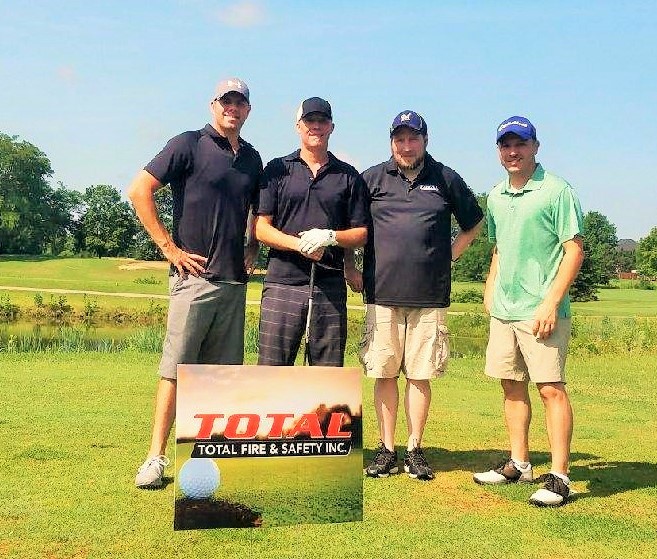
Were it not for the tournament, would these four fire safety men be on the golf course? Golf courses are not typically a fire risk, but fire has been known to destroy the maintenance buildings and club houses that sit adjacent to them. At Total Fire & Safety, our services protect many recreational venues in Chicagoland, Wisconsin and Indiana. And that’s important because such fires break out more often than you think.
In fact, this past May, a Texas and Ohio golf course building were both destroyed from fire.
In Brownsville, Texas, the clubhouse at Valley International Country Club had a blaze on May 13, which most likely began in the kitchen area. Although nobody was hurt, the beautiful venue, including the original two-story clubhouse built in 1910, was ruined. The fire was fueled by a “built-up roof” which was heavier and held the heat more easily as the blaze raged for 12 hours.
Just a few days earlier, fire had destroyed a maintenance shed at the Carlisle Golf Course in Grafton, Ohio. The fire broke out after midnight on May 11 from an unknown cause, but arson is not suspected. The fire department was able to keep the fire from spreading to a nearby residence, but in this case, their challenge was the water source. Since the course was not close to fire hydrants, they had to set up a water shuttle to bring water to the blaze.
It just goes to show how the need for fire safety is everywhere, even in the places we least expect. At Total Fire & Safety, we’re proud to support our clients and keep our recreational areas, as well as our workplace, as safe as possible. If we can help you with your commercial fire protection, please don’t hesitate to contact us at 630-960-5060.
Category: Client Events, Fire News, Fire Safety, Total Fire and Safety Tags: commercial fire protection, fire and safety solutions, golf outing, Total Fire & Safety, Total Fire & Safety client events | Comments Off on Total Fire & Safety Tees it Up!
-
May 26, 2017 by Total Fire and Safety
As the weather warms up, we know that a lot of you will be warming up the grill for barbecuing season. But do you know how to prevent your grill from starting a fire? According to the National Fire Protection Association, between 2009 and 2013, there was an average of 8,900 grill, hibachi, or barbecue-related home fires per year. Here are five important facts about grill safety that will make your backyard the safe haven that you want it to be.
1. Be very careful with liquid gas 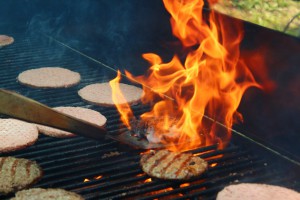 and propane, because they are extremely flammable. The most dangerous type of fuel to use in grills is gas, accounting for 83 percent of all grill fires. Charcoal and other materials account for less fires, but any material can pose a fire risk. and propane, because they are extremely flammable. The most dangerous type of fuel to use in grills is gas, accounting for 83 percent of all grill fires. Charcoal and other materials account for less fires, but any material can pose a fire risk.
2. You should always make sure to clean your grill properly before and after you use it. Improperly cleaned grills are the leading cause of grill fire. For gas grills, you can use a pipe cleaner to clear blockage in the tubes that lead to the burner.
3. Another leading cause of grill fires that use gas is leaks or breaks that can develop in the gas line. It is always a good idea to inspect the pipes and fuel sources before you fire up the grill. Also, make sure there are no sharp bends in the tubing and pipes which might result in unnecessary stress on the system.
4. Always have proper ventilation while grilling. Do not grill indoors, and be cautious with awnings or umbrellas. If you grill indoors, you are not only risking a fire, but also, suffocation from the fumes produced by gas and charcoal grills. Always use grills at least 10 feet away from your house or any building.
5. If you suspect a leak, be careful. Keep open flames and lit cigarettes away from the grill, and if you suspect that there is a leak, play it safe. Do not light the grill if you smell excessive gas, or if you notice any abnormalities in the grill’s fuel system.
It is important to know the facts behind grill safety. Grilling season is upon us, and we want to prevent as many fires as possible during this high-risk season. Proper fire safety systems are an important part of fire prevention, but safe practices are also crucial to a safe environment. If you have any questions about fire safety, whether you’re grilling at home or at your business, you can contact us at 630-960-5060.
Category: Fire News, Fire Safety, Total Fire and Safety Tags: barbecue, barbecue fire safety, barbecue risk, barbecue safety, fire safety, grill fire, grill fire risk, grill fire safety, grill safety, grilling safety | Comments Off on Don’t Get Grilled… on Grill Safety!
-
March 28, 2017 by Total Fire and Safety
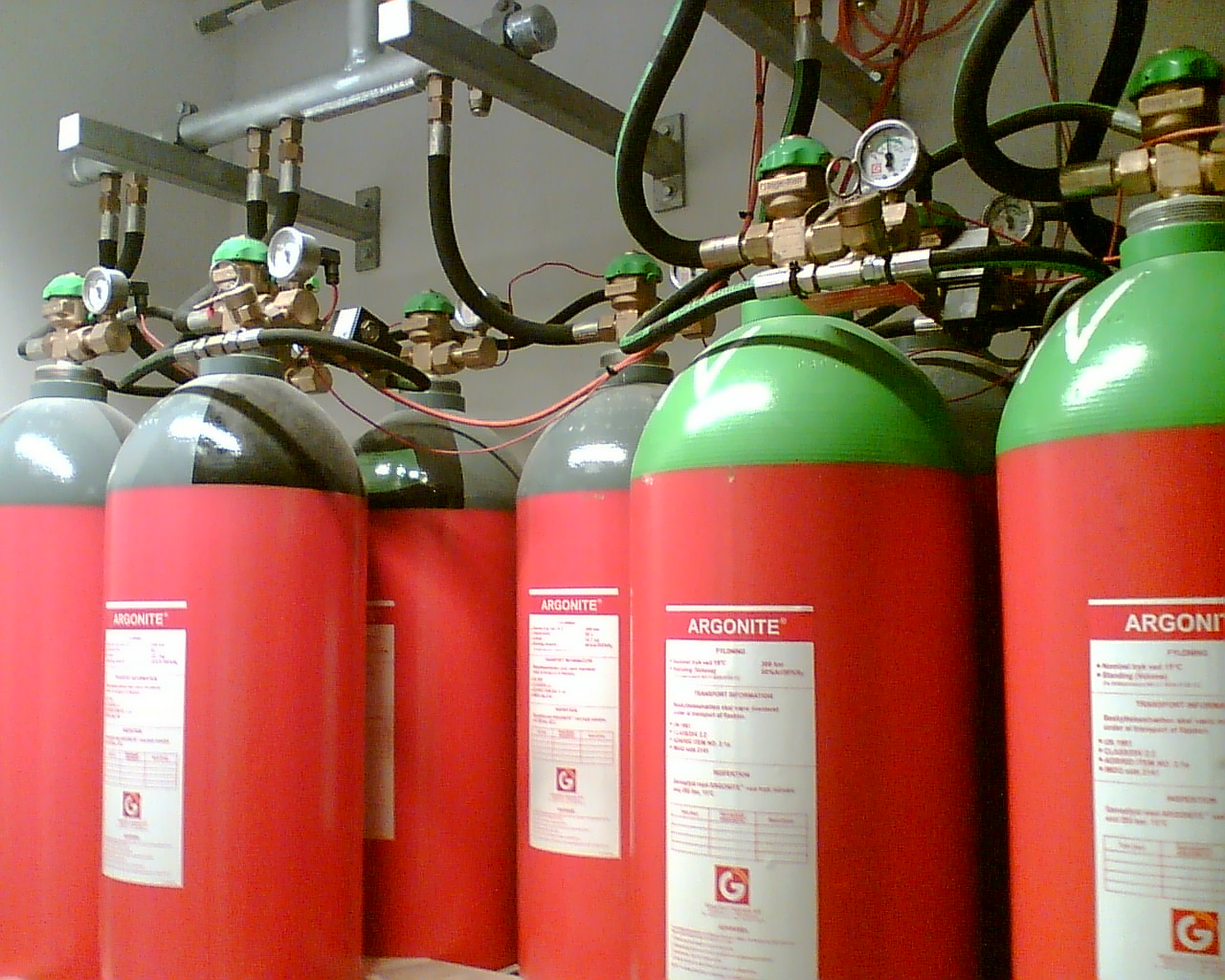
If you have a business that has any sort of valuable electronic equipment, like computers, servers, etc., you need to know about clean agent suppression systems. They are a liquid-free, fire suppression option, unlike sprinklers, that will not harm your electronic devices in the case of a fire and need for fire suppression. Just imagine the damage a sprinkler system would do to your equipment! Clean agents are an excellent alternative for many reasons:
Your computers and data rooms are a fire hazard to begin with. Computers and data rooms need very good ventilation because they can get very hot. The NFPA has specific regulations for computer rooms and electronic equipment areas, because there is a greater risk of fire from electronics.
Your business has a lot to lose from fire damage to electronics. Not only could you lose your equipment, but you could lose crucial data and online business. You could lose millions, literally, in the blink of an eye if a fire rips through the room that stores your equipment.
You won’t have to get soaked with a clean agent. When the system is activated, Halon 1301, a gaseous fire extinguishant, is released into the room. Halon fills the room and extinguishes the fire, but does not leave any residue on surfaces in the room. No mess to clean up afterward… the gas will evaporate and the room will be unharmed.
Because clean agents work by removing oxygen from the room, this kind of suppression system does post some danger to humans. Clean agents are great for rooms that are filled with servers and computers, but not people. There is a risk of suffocation if people are trapped in the room in an emergency situation.
The pros of a clean agent system are many to those areas of your business that require an alternative to sprinklers. At Total Fire & Safety, we are experts in the installation and maintenance of clean agent suppression systems for businesses. If you are considering an installation, contact us at 630-960-5060.
Category: Fire Extinguishers, Suppression system, Total Experience, Total Fire and Safety Tags: clean agent, clean agent suppression, clean agent supression system, Clean Agent System, Clean Agents, commercial fire suppression, fire suppression, fire suppression system, Suppression System | Comments Off on The Best Way to Protect Your Computers: Clean Agent Suppression Systems
-
February 14, 2017 by Total Fire and Safety

If you visit the TFS headquarters in Woodridge, Illinois, make sure you take a look at our newly remodeled training room. Training is essential to what we do at Total Fire & Safety, not only for new employees but to help existing ones stay up-to-date on the latest hazards, fire codes and prevention techniques.
Our existing employees know the training room well. This is a picture of our fire extinguisher division meeting. Every month, each division of Total Fire & Safety, fire extinguisher, sprinkler, fire alarm and backflow, meet for monthly training and information exchange sessions. By gathering together, our team in each division can share information about their experiences in the field and discuss what is working or needs to be improved. Each division has their own concern with fire safety, so holding these division exclusive meetings is very helpful.
Who benefits most from these meetings? The TFS customer!
These meetings are one of many ways TFS is always trying to become more efficient and stay abreast of the latest in fire prevention and NFPA codes for their customers. The meetings help Total Fire & Safety deliver their very best in expertise, installation, maintenance and customer service to all our wonderful customers.
Thank you to all of our customers for making 2016 a great year for us. We promise to do everything we can as your commercial fire protection company to make 2017 a safe one for your commercial fire safety. If you have any questions about fire safety for your business or want to update your fire equipment going into the new year, don’t hesitate to contact us at 630-960-5060.
Category: Fire Safety, Total Fire and Safety Tags: fire professional training, fire safety training, fire training, Total Fire and Safety, total fire training | Comments Off on A New Year in TFS’s Commercial Fire Protection Training Room
-
December 14, 2016 by Total Fire and Safety
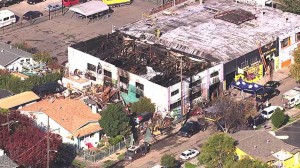 On December 2 in Oakland California, a deadly fire took 36 lives in a warehouse facility turned artist residence known as the Ghost Ship Artist Collective. It took four days for local firefighters to recover the scene. An absolute contributing factor? The lack of a sprinkler and fire alarm systems, blocked and inadequate fire exits and a lack of working fire extinguishers. On December 2 in Oakland California, a deadly fire took 36 lives in a warehouse facility turned artist residence known as the Ghost Ship Artist Collective. It took four days for local firefighters to recover the scene. An absolute contributing factor? The lack of a sprinkler and fire alarm systems, blocked and inadequate fire exits and a lack of working fire extinguishers.
In fact, the few extinguishers found among the bodies were inoperable. Officials say it is the highest number of fatalities in a structure fire in the U.S. in the last 13 years.
The tragedy shed negative light on the building owner, who refused to comply with fire codes and the state of the Oakland housing market, where people endured living in dangerous conditions since there was no other affordable alternative in the area. The city is also under scrutiny since the building had not been inspected for 30 years, and rightly should have been closed down.
But for those of us in fire safety, like Total Fire, the tragedy is a demonstration of the importance of our work, and how what we do saves lives.
The Looming Disaster
The Ghost Ship had been home to numerous fire hazards for some time and was no stranger to the authorities. The facility had been reported for tall weeds, mounds of garbage on the grounds, and illegal conduct of the community within, even though the space was not meant for residential use. The cause of the fire is still under investigation but at first, an old refrigerator was thought to be the cause.
The interior of the building was a chaotic mixture of improper electrical wiring and makeshift staircases, stacks of wood, furniture and other junk scattered around and wooden structures in progress. The fire started on the first floor, and people trying to evacuate had to weave through the inside clutter and climb a rickety, tight staircase to get out. People on the second floor were trapped by smoke and flames.
Many of the bodies were found as they were in their last moments–holding and hugging each other in fear.
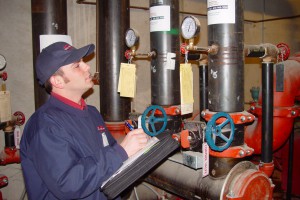
At Total Fire & Safety, we truly believe we do something more than just come to work, collect a pay check and go home. We play an important role in keeping our community safe!
Steven Holowka, our fire alarm division manager, puts it this way: “I tell my team to take the mindset that every building we take care of has someone you love in there. Would you want your loved ones being in a building that wasn’t properly taken care of? Would you feel okay if you one of your loved ones died in a building that wasn’t properly maintained?”
In the case of the Oakland tragedy, an inspection attempt was made as recently as last month when a code enforcement officer responded to complaints about piles of garbage. No one came to the door and the Oakland inspectors are not allowed to gain access to a building without permission.
The blaze started during a rave dance party, and the facility was not equipped or zoned for such a gathering. NFPA reminds us that in the case of nightclubs, theaters and auditoriums where large numbers of people gather, fires are the most deadly when the proper features and systems are not in place.
For theaters, night clubs, venues, etc. NFPA codes call for a considerable number of safety systems and features to be present for these structures, not just a single safety system or feature.
Saving Lives, a System at a Time
When building owners take shortcuts in service, look for the cheapest option or have the mindset that a fire like this could never happen to them, the consequences can be dire. That’s why we make sure we are doing our part in taking care of our customers and ensure that the systems they have onsite are adequate for their needs.
Our entire team, including our administrative employees, field technicians, managers and even our owner believes that it is our responsibility to do our job 100% because in the end we are protecting what matters most–people’s lives.
When we arrive at a facility we..
- TEST and INSPECT to make sure everything is in working order
- PROVIDE REPAIR/INSTALL SERVICE so everything is done correctly and ready to activate in an emergency
- and VERIFY that everything is up to code for the customer.
The fire at the Ghost Ship will rank among the Rhode Island Nightclub fire of 2003 and the Queen of Angels fire from 1958 as tragedies that could have been prevented or lessened considerably had the right life safety systems been in place.
As fire safety systems continue to improve, Jim Pauley of the NFPA warns that “we can’t be complacent just because numbers have gotten better.” It’s important that everyone responsible for the safety of those inside a facility have it properly inspected with well maintained and fully operational fire safety systems in place. Do you?
If you are unsure of whether your building is up to code, please don’t hesitate to contact us at Total Fire & Safety. We take our jobs seriously because we know what we do saves lives!
Category: Fire Alarm Monitoring, Fire code violation, Fire exits, Fire Extinguishers, Fire Extinguishers, Fire News, Fire Safety, Sprinkler Systems, Total Fire and Safety, Uncategorized Tags: fire and safety equipment, Fire Extinguisher, fire news, fire safety in the news, firesprinklerinspections, Ghost ship fire, importance of fire safety | Comments Off on The Ghost Ship Fire: 36 Lives Lost From Lack of Fire Safety Systems
-
November 20, 2016 by Total Fire and Safety

The Total Fire & Safety team was on the scene recently at the 2016 Chicagoland Cooperator’s Condo, HOA, Co-Op and Apt. Expo at Navy Pier in Chicago.
Once again, thousands of board and association members, property managers, homeowners and apartment building owners met for this growing, annual event. They attended educational seminars and browsed the exhibits, where they had a chance to visit with the knowledgeable staff at TFS.
As an expert in commercial fire safety for property owners and apartment buildings, we always enjoy attending the show, familiarizing others with our services but most of all, addressing the attendees’ concerns about their current fire safety solutions. Mainly, we were able to answer the most frequently asked questions on the minds of the property owners such as:
- What fire equipment is required for my property? (At Total Fire & Safety, we can make sure you are compliant with NFPA requirements which vary depending on your structure and occupancy. )
- How can I reduce the cost of my fire safety needs? (Total Fire & Safety can update your old equipment or make sure your current equipment is operable. Often times, updating to a new system, like wireless fire alarm monitoring or low voltage emergency lighting, can help reduce maintenance costs in the long run while improving service.)
- Do I have enough fire alarms? (Talk to us about your needs and we’ll make sure you get the fire alarms you need.)
- What kind of fire safety training is needed for my employees or tenants? (Total Fire & Safety knows what kind of employee fire safety and first aid training is mandatory, or best suited for your building.)
- Do I really need a first aid kit in my building? (Of course! A properly placed first aid kit can supply much needed medical attention when it’s needed most!)
- Why should we pick Total Fire & Safety? (Because for more than twenty years, Total Fire & Safety has led Chicagoland as one of the most reliable, knowledgeable and trustworthy fire and safety companies in Chicagoland!)
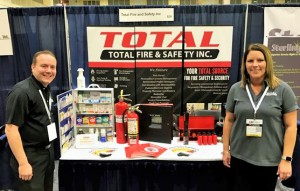 Mark Spinder (outside sales) and Robin Jones (inside business development) at the Cooperator Show.
We look forward to next year’s show and another chance to meet new customers and introduce them to the company that has all the answers for their fire safety needs—Total Fire & Safety! Hope to see you at the Cooperator Expo 2017! In the meantime, if we can ever help you with your fire safety needs, don’t hesitate to contact us at 630.960.5060.
Category: Fire News, Total Fire and Safety Tags: chicagoland's cooperator's condo, expo, fire service expo, HOA, navy pier, Total Fire and Safety | Comments Off on TFS Cooperates at Navy Pier!
-
November 16, 2016 by Total Fire and Safety
Your fire risk is very diffe rent on Thanksgiving Day than it is on any other day of the year. Residential fires are a lot more common, because everyone is cooking! Here are some fire safety facts about Thanksgiving Day that you should be aware of, and some safety tips to remember so you don’t become a part of these statistics. rent on Thanksgiving Day than it is on any other day of the year. Residential fires are a lot more common, because everyone is cooking! Here are some fire safety facts about Thanksgiving Day that you should be aware of, and some safety tips to remember so you don’t become a part of these statistics.
- From 2011 to 2013, there was an estimated 2,100 cases of residential fires per year and approximately 10 deaths, 50 injuries, and $28 million in property loss, according to the National Fire Protection Association.
Be thankful for the chance to be mindful of fire safety at Thanksgiving!
- Most residential fires happen in single family homes, 65 percent, or multifamily homes, 28 percent. A fire could happen in your own neighborhood, or even your own home.
Be thankful for all the working fire extinguishers and smoke detectors in kitchens across the country!
- The peak time for frequency of fires was from noon to 3 p.m., the time when many people are working on preparations for the big meal. This differs from normal days, when residential building fires are most likely to occur during the dinner hours of 5 p.m. – 8 p.m.
Be thankful for properly attended stoves as we prepare the Thanksgiving meal!
- Of all Thanksgiving Day fires surveyed, 73.5 percent were limited to the object of origin; 11.6 percent limited to the room of origin; and 10 percent limited to the building of origin.
Be thankful for knowing how to operate a fire extinguisher to stop a fire before it causes too much damage!
- The majority of fires on Thanksgiving Day are caused by cooking, at 72 percent. Practice safe cooking by checking temperatures frequently, being extra careful with open flames and ovens, and not overcrowding the kitchen.
Be thankful for cautious holiday cooks who observe fire safety measures!
There is one last reminder that turkey lovers should keep in mind this year. Deep frying turkeys is a tradition for some Americans, but it is also a dangerous fire hazard. Watch this video to see a fiery demonstration of what can go wrong if you deep fry a turkey unsafely.
Be thankful for deep frying with caution and care!
Total Fire & Safety wishes you a happy holiday! If you are interested in a kitchen suppression system, safety inspection, or fire extinguisher training in preparation for Turkey Day, contact us at 630-960-5060.
Category: Fire Safety, Total Fire and Safety, Trends Tags: fire safety, holiday fire safety, thanksgiving fire safetu, thanksgiving fire safety, thanksgiving fire statistics, thanksgiving safety | Comments Off on Thankful Fire Safety Facts for 2016
-
October 24, 2016 by Total Fire and Safety
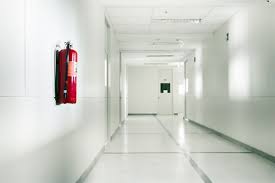 National Fire Prevention Week has been a yearly campaign since 1922, occurring on the Sunday through Saturday period that includes the date October 9. It was established to commemorate the Great Chicago Fire on October 8-9, 1871. This infamous tragedy claimed 250 lives, destroyed more than 17,400 structures and left 100,000 people homeless. Fire prevention week is a day to remember this event and also what kind of effect a fire could potentially have on our lives. National Fire Prevention Week has been a yearly campaign since 1922, occurring on the Sunday through Saturday period that includes the date October 9. It was established to commemorate the Great Chicago Fire on October 8-9, 1871. This infamous tragedy claimed 250 lives, destroyed more than 17,400 structures and left 100,000 people homeless. Fire prevention week is a day to remember this event and also what kind of effect a fire could potentially have on our lives.
No matter what kind of business you own or manage, October is also the perfect time to remember how devastating fire can be, and how important it is to be ready for an emergency. A fire can cause serious damage to your company’s facility and equipment, not to mention employees! This is as good a month as any to make sure you have these five ‘checks’ taken care of within the boundaries of your office and/or facilities.
1. Are your fire hazard risks assessed properly? Some businesses have greater fire risks than others, but there are very few businesses that have none. They all need to be properly assessed so the proper prevention can be implemented accordingly. Some local governments offer fire marshal visits, or workplace fire risk assessment guidance from your building’s property manager. A commercial fire safety firm can also help you mitigate problems.
2. Do you have emergency plans in place? Do you have an evacuation plan and do your employees know what to do in case of a fire? Do they fire training, so that they know how to use fire extinguishers, and when to use them?
3. Do you have the right fire protection equipment installed? Your fire safety equipment needs likely include sprinkler systems, but you might need more to be up to code or compliant with regulations. Industries dealing with machinery that overheats or flammable substances might need a suppression system tailored to your business.
4. Do you have scheduled routine equipment inspections? Even if you have the right sprinkler systems, fire extinguishers, and suppression systems, they also need routine inspections (at least annually) to keep everything in working order. Know what tests you can do yourself, and which require professional visits from fire alarm technicians.
Even though Fire Prevention Week is over, it’s not too late to think about your fire prevention and safety. Perhaps now is the time to take action. Contact us or call 1.630.960.5060 for more information on any of the fire steps detailed above, from alarm installation to employee training programs.
Category: Fire Alarm Monitoring, Fire Extinguishers, Fire News, Fire Safety, Sprinkler Systems, Total Fire and Safety Tags: commercial fire prevention, fire extinguisher regulations, fire prevention, fire prevention for businesses, fire prevention week, fire week, national fire prevention week | Comments Off on How Is Your Company’s Fire Prevention? Four Questions for Business Owners!
|

|
|
|
|
|
|

 Facebook
Facebook
 Instagram
Instagram
 LinkedIn
LinkedIn











